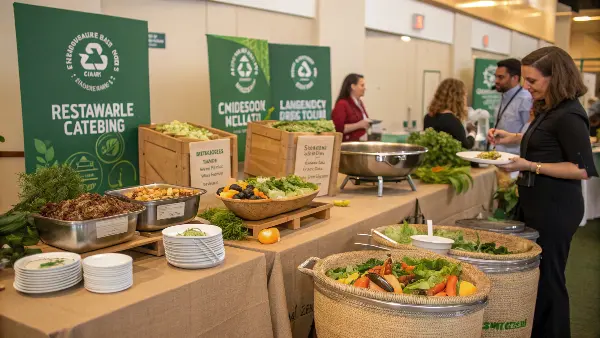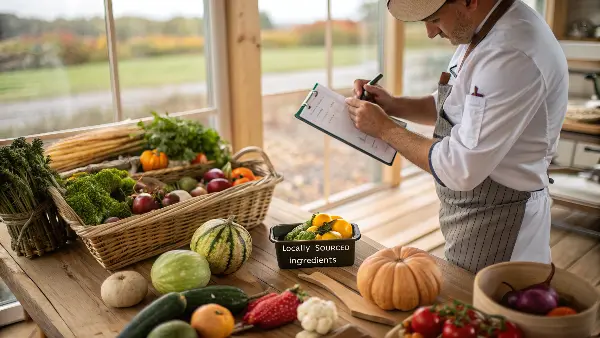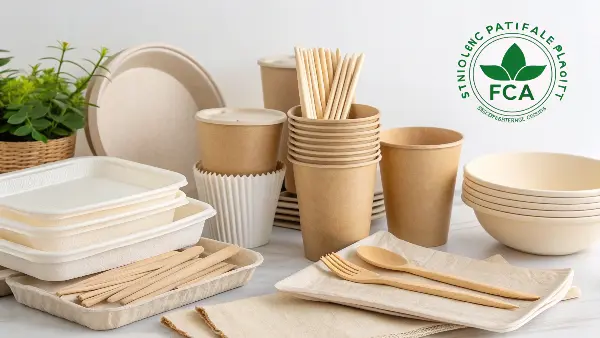Planning an event is tough enough, but the mountain of plastic waste left behind can feel overwhelming. This not only harms the environment but also clashes with your brand’s commitment to sustainability. But there’s a better way. With the right strategy and supplies, you can host an impressive event that leaves a positive impact, not a pile of trash.
To host a zero-waste event, focus on key areas: plan a sustainable menu with locally sourced ingredients, replace single-use plastics with compostable or reusable tableware, and implement a robust system for managing leftovers and waste streams. Educating your team and guests is also crucial for success. This approach not only minimizes environmental impact but also enhances your brand’s reputation for sustainability.

I’ve worked with many packaging specialists over the years, like Jacky from a major Canadian brand. He needed to ensure his company’s events reflected their deep commitment to the planet. Together, we mapped out a plan that replaced waste with thoughtful, sustainable choices. It’s not just about swapping a plastic fork for a wooden one; it’s a holistic approach.
Let’s dive into the practical steps that can turn your next catered event into a model of sustainability.
How Can Menu Planning and Ingredient Sourcing Reduce Your Event’s Footprint?
Your event menu might be unintentionally wasteful before a single guest arrives. Ingredients flown from halfway across the world and poor portion planning lead to a massive carbon footprint and excessive food waste. But simple, thoughtful menu design and local sourcing are your most powerful first steps toward achieving a zero-waste goal.
Sustainable menu planning minimizes waste by focusing on seasonal, locally-sourced ingredients, which drastically reduces transportation emissions. Prioritize plant-based options, as they have a lower environmental impact. Accurate portion control is also key to preventing food waste. By partnering with local farmers and suppliers, you get fresher ingredients, support your community, and shrink your event’s carbon footprint.

I always advise clients that the journey to a zero-waste event begins in the kitchen, long before the first plate is served. It’s a change in mindset from "what do we want to serve?" to "what’s available locally and sustainably that we can serve?". This simple shift has a huge ripple effect.
The Pillars of a Low-Waste Menu
Designing a sustainable menu is about being smart and creative. A "root-to-stem" or "nose-to-tail" cooking philosophy is a great example. This means using every part of the ingredient, like turning vegetable peels into stock or using less common cuts of meat. It reduces food waste to nearly zero and often introduces guests to new, exciting flavors. Leaning into plant-forward dishes is another powerful strategy. These meals generally require fewer natural resources like water and land to produce compared to meat-heavy menus. It doesn’t mean you have to go fully vegetarian, but making plants the star of the show makes a significant environmental difference.
Sourcing with Intention
Building relationships with local suppliers is one of the most rewarding parts of this process. It creates a transparent supply chain where you know exactly where your food is coming from. Look for farmers and producers with certifications like Organic or Fair Trade, as this adds another layer of assurance. This direct partnership not only ensures you get the freshest ingredients but also reinvests money into your local economy. The difference between this and traditional sourcing is stark.
| Aspect | Traditional Sourcing | Sustainable Sourcing |
|---|---|---|
| Origin | Global, often untraceable | Local, regional, traceable |
| Seasonality | Not a primary concern | A key planning factor |
| Supplier | Large, anonymous distributors | Local farmers, co-ops, artisans |
| Impact | Higher carbon footprint | Lower carbon footprint, supports local economy |
| Waste | Higher potential for spoilage | Fresher, less spoilage, promotes full-ingredient use |
What Are the Best Eco-Friendly Alternatives to Single-Use Plastic Tableware?
We’ve all seen it: overflowing bins filled with plastic plates and cutlery after an event. This sight is an environmental nightmare and a direct contradiction to any green business claims. These items choke our landfills and oceans for centuries. Fortunately, high-quality, certified compostable alternatives now offer a guilt-free and elegant solution for any event.
The best alternatives to plastic are certified compostable and biodegradable materials. Bagasse (sugarcane fiber) makes sturdy plates and containers, while PLA (corn starch) is perfect for clear cups and cutlery. FSC-certified wood and paper products are ideal for cutlery, straws, and napkins. These materials are designed to break down into nutrient-rich compost under the right conditions, fully closing the loop from production to disposal.

For a client like Jacky, choosing the right material is about balancing performance, compliance, and guest experience. He can’t afford to have a fork snap or a plate get soggy. I always reassure him that today’s eco-friendly options are engineered to be just as reliable as their plastic counterparts, if not more so.
A Guide to Sustainable Materials
Navigating the world of eco-materials can seem complex, but it’s straightforward once you know the key players. Each material has its best use case, and understanding them helps you make the right choice for your specific needs. It’s not just about being "not plastic"; it’s about choosing the smartest material for the job.
- Bagasse (Sugarcane): This is the fibrous pulp left over after juice is extracted from sugarcane. It’s a brilliant resource because it’s an agricultural byproduct. We mold it into incredibly sturdy, microwave-safe, and grease-resistant plates, bowls, and takeout containers.
- PLA (Polylactic Acid): Made from fermented plant starches like corn, PLA is a bioplastic. It’s perfect for products that need to be clear, like cold cups, lids, and some cutlery. It looks and feels like traditional plastic but is commercially compostable.
- Wood/Bamboo: For cutlery, nothing beats the classic feel of wood or bamboo. It’s strong, stylish, and fully biodegradable. We ensure all our wood products are FSC-certified, meaning they come from responsibly managed forests.
- Paper/Cardboard: An old favorite for a reason. Modern FSC-certified paper cups, straws, and napkins are excellent choices. Many paper cups now use a PLA lining instead of a plastic one to make them fully compostable.
The Importance of Certification
This is a point I always stress with my clients: look for the certifications. Without them, "eco-friendly" is just a marketing term. Certifications like BPI, TÜV Austria (OK Compost), and ASTM D6400 are your guarantee that a product has been scientifically tested and proven to break down in a commercial composting facility as claimed. These standards are non-negotiable for any business serious about its environmental promises. They ensure you’re providing a genuinely sustainable solution, not just "greenwashing."
How Do You Effectively Manage Waste and Educate Guests at the Event?
You’ve planned the perfect sustainable menu and sourced the best compostable supplies. But the job isn’t done. If guests don’t know where to toss their compostable fork, your entire effort can fall apart. Effective waste management on-site and clear communication are what turn good intentions into a true zero-waste success.
Set up clearly labeled waste stations with three bins: Compost, Recycling, and Landfill. Use simple graphics and colors to make sorting intuitive for guests. Station knowledgeable staff or volunteers near the bins to gently guide people. Also, use small signs on tables or menus to briefly explain your zero-waste goals and thank guests for their participation in helping you achieve them.

The final piece of the puzzle is execution on the day of the event. I’ve found that guests are almost always excited to participate when they understand the "why" behind the different bins. It makes them feel like they are part of a positive movement.
Setting Up for Success: The Three-Bin System
Your best tool for on-site waste management is a simple, visual, and well-placed three-bin system. Don’t hide the bins in a corner; make them visible and accessible. clarity is everything.
- Compost Bin: This is for all food scraps and certified compostable tableware (your bagasse plates, PLA cups, wood cutlery). The sign should be green and have images of what goes inside.
- Recycling Bin: For items like aluminum cans and glass bottles. This bin should have a blue sign with clear visuals.
- Landfill Bin: This should be the smallest bin! It’s for the few items that can’t be composted or recycled, like condiment packets or certain types of wrappers. A black or grey sign works best.
Communication Is Key
You can’t expect guests to know what to do automatically. A little education goes a long way. Before the event, you can mention your sustainability goals in the invitation. During the event, a few simple tactics work wonders. A small note on the menu or a card on each table that says, "We’re proud to be a zero-waste event! Please help us by sorting your waste at our stations," is very effective. The most impactful method is having a friendly "sustainability ambassador" near the waste stations. This person can answer questions and guide guests, turning a moment of potential confusion into a positive and educational interaction. This simple human touch ensures your system works and reinforces your brand’s commitment in a very personal way.
Conclusion
Hosting a zero-waste event is no longer a niche idea; it’s an achievable standard. By focusing on sustainable menu planning, choosing certified compostable supplies, and implementing a clear on-site waste strategy, you can drastically reduce your environmental footprint. This commitment doesn’t just benefit the planet—it elevates your brand and resonates deeply with today’s conscious consumer.


